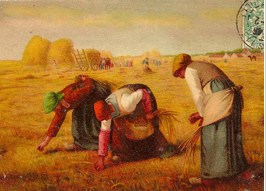Love among the haystacks
As I have said before doing genealogy is like being a detective - ferreting out links and pieces of evidence. analyzing it and then putting it all together with very satisfying results.
What you can glean from census records can not only be terribly useful, but also rather interesting for what it can tell us about our ancestors. Of course, registration and transcription, ignorance of the location of places, as well as inconsistencies, and the information required and actually provided, make the process of discovery harder, but more rewarding. You might fairly easily believe and find that Richard Keon and Richard Keen were the same chap, as well as Lewis Leak, L. Leake and Louis Leek. We know that Raitt was spelled in the past variously as Rait and Reat. You might find Smart in some instances spelled Smartt, but who would have thought that Louisa Smart would, in the 1891 English census, have been rendered as Louise Sewart? There are other errors for the family here apart from the surname - Bedford for Bidford, Walford for Welford - of course, in mitigation, handwriting is often difficult to read correctly - I can often not decipher my own scrawl from years ago! The missing Smart family from the 1891 census, when they were in all the others, was just a case of ploughing through all the soundex entries until the family was eventually found as Sewart.
Then you have place names: early census records can show the address, civil parish, municipal borough, registration district, sub district, enumeration district, ecclesiastical parish and county. Records for people living in the village of Binton in Warwickshire, for instance, can show the registration district as Stratford on Avon or simply Stratford and the sub district as Old Stratford or Stratford on Avon. That's not too bad, but Bidford or Bidford on Avon, Warwickshire, can be in the registration district of Alcester or Evesham, in the ecclesiastical district of Worcester in the county of Warwickshire. Confusion can be caused by later transcribers because Worcester is actually the county town of Worcestershire. And Evesham, a common registration place, is an area spanning several counties including the above. The same person can be given as born in the same village (eg Pebworth) but in two different counties (Gloucestershire or Worcestershire) depending on which district or part of the record the transcriber used. And because of this a person can, in a different census, be given as being born outside the census county even while working in the same village! Of course, some people were often illiterate or, while they might know the name of the village in which they were born, simply did not know which district or county it belonged to. Boundaries changed too over time.
However, the point of all this is that with a little diligence and in many cases just pure luck you can find out some rather nice facts. Take, for instance, young William Leek, born Binton, Warwickshire in July 1856 who was not at home with his family in the 1871 census. Well, he could very well be the William Leek, aged 14, occupation youthful offender, residence Warwickshire Reformatory down the road in Weston. After his spell in reform school, William obviously settled down, got married, and raised a family in Binton. His father was Thomas Leek, but his mother is simply given as Hannah - as for all their other children and as so often the case. Thomas, appears in the 1841 census for Binton, age 23, working as a male servant (presumably agricultural labourer) on the farm of John Canning. From BMD it appears that Thomas married a Hannah Bennet in 1841 (marriage registered in the district of Stratford on Avon). So the name ties in with the date of birth of their first child - and also with other censuses. On checking the 1841 census to see where a Hannah Bennet might have been in 1841, it turns out that there was a young female servant, aged 20, of the same name in the same household of farmer John Canning! The names, the ages, the dates and the place from later censuses can have no other conclusion that Thomas and Hannah were working together on the same farm in 1841 and fell for each other!
Thursday, 31 December 2009

